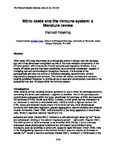Nitric oxide and the immune system: a literature review
| dc.contributor.author | Hosking, H. | |
| dc.date.accessioned | 2019-05-13T13:32:58Z | |
| dc.date.available | 2019-05-13T13:32:58Z | |
| dc.date.issued | 2009 | |
| dc.identifier.citation |
Hosking, H. (2009) 'Nitric oxide and the immune system: a literature review', The Plymouth Student Scientist, p. 270-278. | en_US |
| dc.identifier.issn | 1754-2383 | |
| dc.identifier.uri | http://hdl.handle.net/10026.1/13880 | |
| dc.description.abstract |
Nitric oxide (NO) was discovered as a biologically active molecule over two decades ago and it has since been recognised as one of the most versatile components of the immune system, with involvement in both cytotoxic and regulatory functions. It is a readily diffusible gas that has been established as a universal messenger, capable of mediating cell-cell communication throughout the body. It is involved in the pathogenesis and also the control of infectious diseases, autoimmunity, chronic degenerative diseases and tumours. This review will collate, contrast and compare recently published literature, to provide an up-to-date and contemporary overview of the substantial role that NO plays within the immune system. | en_US |
| dc.language.iso | en | en_US |
| dc.publisher | University of Plymouth | |
| dc.rights | Attribution 3.0 United States | * |
| dc.rights.uri | http://creativecommons.org/licenses/by/3.0/us/ | * |
| dc.subject | Nitric oxide | en_US |
| dc.subject | immune system | en_US |
| dc.subject | literature review | en_US |
| dc.subject | cytotoxic | en_US |
| dc.subject | universal messenger | en_US |
| dc.subject | cell-cell communication | en_US |
| dc.subject | cell | en_US |
| dc.subject | infectious diseases | en_US |
| dc.subject | autoimmunity | en_US |
| dc.title | Nitric oxide and the immune system: a literature review | en_US |
| dc.type | Article | |
| plymouth.issue | 2 | |
| plymouth.volume | 2 | |
| plymouth.journal | The Plymouth Student Scientist |



